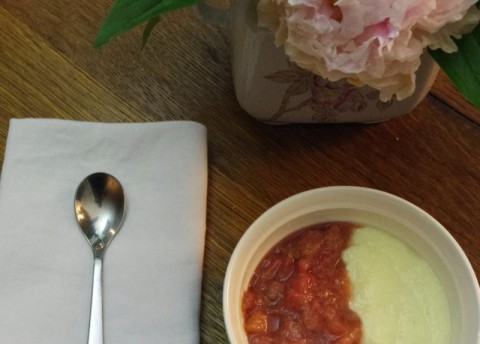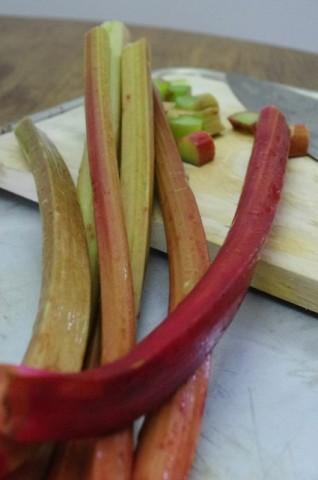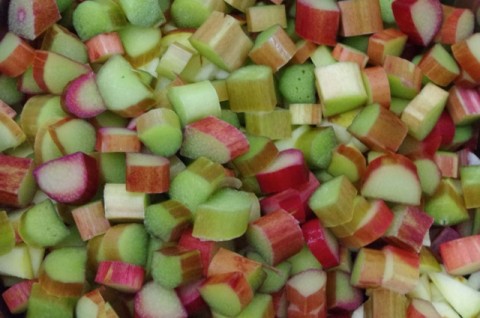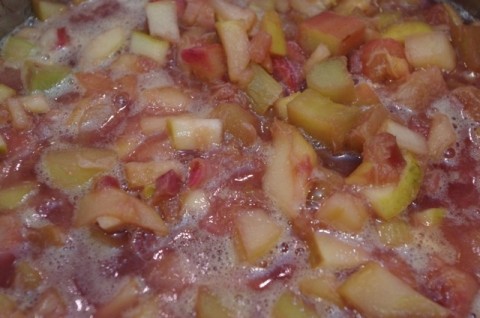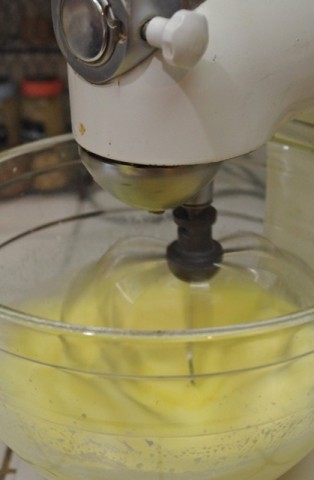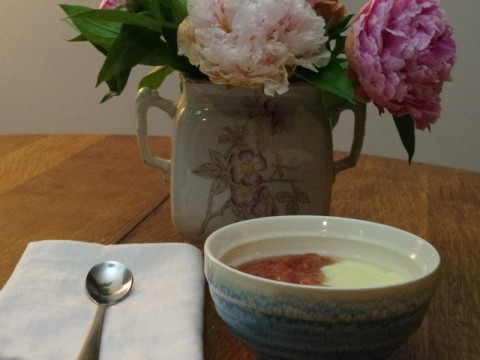The rhubarb is a vegetable most often used as a fruit – in much the same way that the tomato is a fruit used as a vegetable. But unlike the ubiquitous tomato, rhubarb sometimes stymies American cooks. What’s to be done with this briefly available, bitter, even poisonous plant?
Well, there’s pie. In the nineteenth century, rhubarb was so strongly associated with pie that it was commonly called pie plant. And then there are the many variants of pie: crisps, crumbles, buckles. Rhubarb is so very assertive that it was not much eaten until and unless it could be sugared; prior to that, it was prized only for its medicinal properties. But other fruits have a mellowing effect on rhubarb’s harshness. Apples, especially, soften it without transforming its flavor. Personally, I believe that it’s a crime against strawberries to pair them with rhubarb – and it’s underselling the rhubarb as well!
While I admit that rhubarb’s robust tang needs to be mellowed for human consumption, it ought not to be muddied by other strong flavors. That’s why I favor the simplest preparations: rhubarb fool and rhubarb and custard. These desserts are deservedly classics in England, where rhubarb continues to be much more popular than in the US, and both treatments rely on rhubarb’s bright, tart flavor juxtaposed to something rich and creamy. Simultaneously stimulating and satisfying, they please the palate in multiple ways. It doesn’t hurt that they are dead easy, too.
Firstly, selecting rhubarb. The plant is prized for its beautiful red stalks, but color is actually no indication of flavor or texture here: red stalks, pink mottled ones, or light green ones will all serve you well. (The exception is forced rhubarb, the stalks of which are bright red, tender, and sweeter than usual. Rhubarb forcing is common in the UK but very rare in the US.) Of more importance than the look of the stalks is their size. Choose slender stalks; they are more tender. Larger, more mature stalks often have a brighter color but they also have thicker fibers. Whether you harvest your own rhubarb or buy it at a market, you will want to trim off all traces of the poisonous leaves. These leaves are full of oxalic acid; you would have to consume a very large quantity of them to injure yourself, but nonetheless it is preferable to avoid them entirely by the simple expedient of cutting them off.
I dice my rhubarb and simmer it very gently until it breaks down, like applesauce. Unlike applesauce, which takes on a richer color as it cooks, rhubarb may lose its glorious red-pink hue and turn a disappointing grey-brown. Younger, greener rhubarb is especially prone to this. Do not let it deter you. The resulting tart, tangy rhubarb sauce is as bright on the tongue as it is dull to the eye.
To make a fool, let the rhubarb sauce cool; you may even reserve it a few days. When you are ready to serve it, whip some cream and fold in the sauce. You will want perhaps twice or three times the volume of whipped cream as of rhubarb sauce.
To make the classic English dessert, rhubarb and custard, simply serve the rhubarb sauce alongside a puddle of mild, creamy custard. Nothing could be simpler or more satisfying.
Rhubarb Sauce
Rhubarb
Sugar or honey
I find that six stalks of rhubarb will make four servings of sauce. You may make any quantity you wish, as it keeps well. Generally speaking, the rhubarb will reduce to one-half or one-third of the volume you started with.
Trim, wash, and chop the rhubarb stalks into, oh, a half-inch dice; if they are mature and thick, you will want to split them first. Put them in a saucepan on low. For every three stalks, add two tablespoons of sugar. Add just enough water to cover the bottom of the saucepan. You may make the custard while the rhubarb simmers; it will take about 20 minutes. You may taste for sweetness occasionally, and add more sugar, honey, or other sweetener. When the rhubarb has lost its shape and its color, reaching the consistency of applesauce, it’s done. Taste one more time and sweeten if necessary. Set it aside to cool.
Custard
2 whole eggs
2 cups of whole milk
splash vanilla
¼ cup sugar
1 tablespoon cornstarch (optional)
Traditional English custard is a thick, smooth, pourable sauce. I find that a thicker texture stands up to rhubarb better than the more usual pourable custard, something like a cross between a custard and a pudding. And so I have added cornstarch to my custard recipe. If you prefer a thinner custard, omit it.
Heat the milk until it steams. You can use a saucepan, but I prefer a glass pitcher in the microwave because it makes for easier pouring later. Beat the eggs with the sugar; beat in the cornstarch, if using, and finally the vanilla. While beating, pour in a thin stream of hot milk. Continue until all the milk is incorporated. Transfer the custard to a saucepan on medium low heat. Whisk or stir attentively until the mixture thickens enough to coat the back of a spoon. Remove from heat immediately and allow to cool.
Rhubarb and Custard Together!
If you cannot wait for your sauces to chill, you will be delighted to hear that they are even better warm. Pour equal quantities of rhubarb and custard into each bowl, carefully, so that they sit side-by-side and do not combine. Consume with relish.
